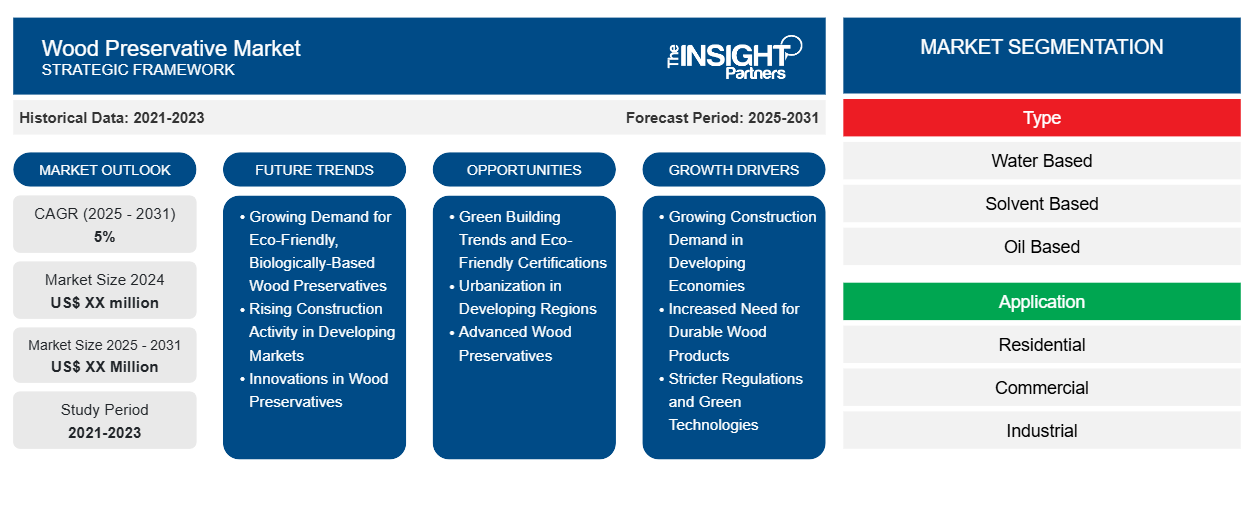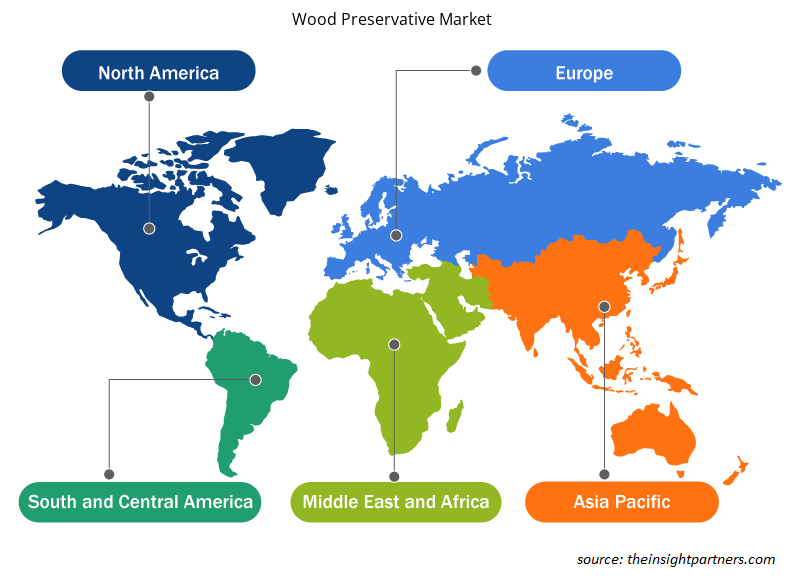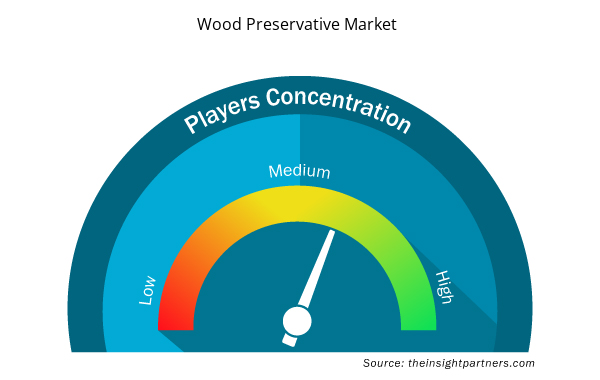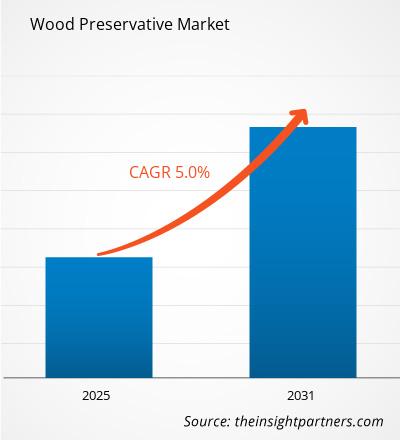Se espera que el mercado de conservantes de madera registre una CAGR del 5% entre 2025 y 2031, con un tamaño de mercado que se expandirá de US$ XX millones en 2024 a US$ XX millones en 2031.
El informe está segmentado por tipo (a base de agua, a base de solventes, a base de aceite). Además, presenta un análisis basado en la aplicación (residencial, comercial, industrial). El análisis global se desglosa a nivel regional y por países principales. Geográficamente, el mercado se divide en América del Norte, Europa, Asia Pacífico, Oriente Medio y África, y América del Sur y Central. El informe ofrece el valor en USD para el análisis y los segmentos mencionados.
Propósito del Informe
El informe "Mercado de Conservantes de Madera" de The Insight Partners busca describir el panorama actual y el crecimiento futuro, los principales factores impulsores, los desafíos y las oportunidades. Esto proporcionará información a diversos actores del sector, como:
- Proveedores/Fabricantes de Tecnología: Para comprender la dinámica cambiante del mercado y conocer las oportunidades potenciales de crecimiento, lo que les permitirá tomar decisiones estratégicas informadas.
- Inversores: Realizar un análisis exhaustivo de tendencias respecto a la tasa de crecimiento del mercado, las proyecciones financieras del mercado y las oportunidades que existen en toda la cadena de valor.
- Organismos reguladores: Regular las políticas y las actividades policiales en el mercado con el objetivo de minimizar el abuso, preservar la confianza de los inversores y defender la integridad y estabilidad del mercado.
Segmentación del mercado de conservantes de madera
Tipo
- A base de agua
- A base de solventes
- A base de aceite
Solicitud
- Residencial
- Comercial
- Industrial
Personalice este informe según sus necesidades
Obtendrá personalización en cualquier informe, sin cargo, incluidas partes de este informe o análisis a nivel de país, paquete de datos de Excel, así como también grandes ofertas y descuentos para empresas emergentes y universidades.
Mercado de conservantes de madera: Perspectivas estratégicas

- Obtenga las principales tendencias clave del mercado de este informe.Esta muestra GRATUITA incluirá análisis de datos, desde tendencias del mercado hasta estimaciones y pronósticos.
Factores que impulsan el crecimiento del mercado de conservantes de madera
- Creciente demanda de productos de construcción en las economías en desarrollo: Esta es una de las razones del crecimiento del mercado de conservantes de madera: la creciente tendencia en la construcción de viviendas, tanto privadas como privadas, en las economías en desarrollo. Con esta creciente demanda en la construcción, también aumentará el consumo de productos de madera tratados.
- Mayor demanda de productos de madera duraderos: La demanda de productos de madera duraderos y resistentes a la descomposición ha incrementado la demanda de conservantes para la madera, especialmente para muebles de exterior, cercas y diversas aplicaciones en la construcción. Los consumidores ahora buscan madera más resistente a los factores ambientales y con una vida útil más larga.
- Regulaciones más estrictas y tecnologías ecológicas: Las regulaciones más estrictas y la adopción de conservantes más ecológicos motivan la invención y la adopción de nuevas tecnologías de conservación de la madera con menor toxicidad. Esto anima a los fabricantes a invertir en investigación e innovación para cumplir con las nuevas exigencias regulatorias.
Tendencias futuras del mercado de conservantes de madera
- Creciente demanda de conservantes de madera ecológicos y de base biológica: La creciente concienciación está llevando a consumidores y empresas a buscar conservantes de madera respetuosos con el medio ambiente. Este interés por las fuentes naturales, especialmente los conservantes de origen vegetal o biológico, menos tóxicos y contaminantes que los tratamientos químicos convencionales, está ganando cada vez más popularidad.
- Aumento de la actividad de construcción en los mercados en desarrollo: El crecimiento de la actividad de construcción global a gran escala en los mercados en desarrollo está impulsando el crecimiento de los conservantes de madera. Los conservantes de madera sellan la madera para protegerla contra la descomposición, los ataques de insectos y la intemperie, impulsando así el crecimiento del sector residencial y comercial.
- Innovaciones en conservantes de madera: Los conservantes de madera modernos están avanzando gracias a innovaciones en sus formulaciones, lo que los hace más eficaces y duraderos. Ahora utilizan nanotecnología, avances en tratamientos químicos y métodos de aplicación mejorados para prolongar la vida útil de los productos de madera y reducir los costos de mantenimiento gracias a su resistencia al moho, los insectos y la humedad.
Oportunidades de mercado para conservantes de madera
- Tendencias de construcción ecológica y certificaciones ecológicas: Con el auge de la construcción sostenible, el mercado de conservantes de madera también puede atender al sector de la construcción ecológica. Actualmente, se puede afirmar que los productos están capitalizando la tendencia ecológica hacia productos no tóxicos, ecológicos y con certificaciones que cumplen con las normativas ambientales, para adaptarse a la tendencia hacia edificios más ecológicos y eficientes energéticamente.
- Urbanización en regiones en desarrollo: La urbanización incrementa la demanda en las zonas geográficas en desarrollo, al igual que ocurre con las maderas tratadas, ya sea para proyectos de construcción o para muebles e infraestructura. Esto también puede brindar oportunidades para que los fabricantes de conservantes de madera amplíen sus líneas de productos y accedan a mercados regionales de rápido crecimiento como Asia y África.
- Conservantes avanzados para madera: Los conservantes altamente avanzados que ofrecen beneficios más duraderos, un secado más rápido y una mayor resistencia a los riesgos ambientales presentan importantes oportunidades de mercado. La innovación en nanotecnología y soluciones de origen biológico diferenciaría a un producto y atraería a los consumidores que buscan mayor rendimiento y sostenibilidad en los tratamientos para la madera.
Perspectivas regionales del mercado de conservantes de madera
Los analistas de Insight Partners han explicado detalladamente las tendencias regionales y los factores que influyen en el mercado de conservantes de madera durante el período de pronóstico. Esta sección también analiza los segmentos y la geografía del mercado de conservantes de madera en América del Norte, Europa, Asia Pacífico, Oriente Medio y África, y América del Sur y Central.

- Obtenga los datos regionales específicos para el mercado de conservantes de madera
Alcance del informe de mercado de conservantes de madera
| Atributo del informe | Detalles |
|---|---|
| Tamaño del mercado en 2024 | US$ XX millones |
| Tamaño del mercado en 2031 | US$ XX millones |
| CAGR global (2025-2031) | 5% |
| Datos históricos | 2021-2023 |
| Período de pronóstico | 2025-2031 |
| Segmentos cubiertos | Por tipo
|
| Regiones y países cubiertos | América del norte
|
| Líderes del mercado y perfiles de empresas clave |
|
Densidad de actores del mercado de conservantes de madera: comprensión de su impacto en la dinámica empresarial
El mercado de conservantes de madera está en rápido crecimiento, impulsado por la creciente demanda del usuario final debido a factores como la evolución de las preferencias de los consumidores, los avances tecnológicos y un mayor conocimiento de los beneficios del producto. A medida que aumenta la demanda, las empresas amplían su oferta, innovan para satisfacer las necesidades de los consumidores y aprovechan las tendencias emergentes, lo que impulsa aún más el crecimiento del mercado.
La densidad de actores del mercado se refiere a la distribución de empresas o compañías que operan en un mercado o sector en particular. Indica cuántos competidores (actores del mercado) hay en un mercado determinado en relación con su tamaño o valor total.
Las principales empresas que operan en el mercado de conservantes de madera son:
- BASF Wolman
- Conservante de madera Cooper Care
- Janssen Pharmaceutica
- Productos químicos KMG
- Cobre
Descargo de responsabilidad : Las empresas enumeradas anteriormente no están clasificadas en ningún orden particular.

- Obtenga una descripción general de los principales actores clave del mercado de conservantes de madera
Puntos clave de venta
- Cobertura integral: el informe cubre de manera integral el análisis de productos, servicios, tipos y usuarios finales del mercado de conservantes de madera, proporcionando un panorama holístico.
- Análisis de expertos: el informe se compila con base en el conocimiento profundo de expertos y analistas de la industria.
- Información actualizada: El informe asegura relevancia comercial debido a su cobertura de información reciente y tendencias de datos.
- Opciones de personalización: este informe se puede personalizar para satisfacer los requisitos específicos del cliente y adaptarse adecuadamente a las estrategias comerciales.
Por lo tanto, el informe de investigación sobre el mercado de conservantes de madera puede ayudar a descifrar y comprender el panorama de la industria y sus perspectivas de crecimiento. Si bien existen algunas preocupaciones válidas, las ventajas generales de este informe suelen superar las desventajas.
- Análisis histórico (2 años), año base, pronóstico (7 años) con CAGR
- Análisis PEST y FODA
- Tamaño del mercado Valor/volumen: global, regional, nacional
- Industria y panorama competitivo
- Conjunto de datos de Excel


- Wheat Protein Market
- Data Annotation Tools Market
- Lyophilization Services for Biopharmaceuticals Market
- Fish Protein Hydrolysate Market
- Mesotherapy Market
- Ceiling Fans Market
- Asset Integrity Management Market
- Frozen Potato Market
- Hot Melt Adhesives Market
- Pharmacovigilance and Drug Safety Software Market

Report Coverage
Revenue forecast, Company Analysis, Industry landscape, Growth factors, and Trends

Segment Covered
This text is related
to segments covered.

Regional Scope
North America, Europe, Asia Pacific, Middle East & Africa, South & Central America

Country Scope
This text is related
to country scope.
Preguntas frecuentes
The report can be delivered in PDF/Word format, we can also share excel data sheet based on request.
Based on geography, North America held the largest share of the wood preservatives market.
BASF Wolman, Cooper Care Wood Preservative, Janssen Pharmaceutica, KMG Chemicals, Koppers, Lanxess, Lonza, Remmers, Rutgers Organics, Troy Corporation are the key players operating in the wood preservatives market.
On the basis of geography, the wood preservatives market is classified into North America, Europe, Asia Pacific, Middle East and Africa, and South and Central America.
The requirement for durable and non-decay wood products has increased the demand for wood preservatives due to outdoor furniture, fencing, and many applications in construction, propelling market growth.
The Wood Preservative Market is estimated to witness a CAGR of 5% from 2023 to 2031
Trends and growth analysis reports related to Chemicals and Materials : READ MORE..
The List of Companies
- BASF Wolman
- Cooper Care Wood Preservative
- Janssen Pharmaceutica
- KMG Chemicals
- Koppers
- Lanxess
- Lonza
- Remmers
- Rutgers Organics
- Troy Corporation
The Insight Partners performs research in 4 major stages: Data Collection & Secondary Research, Primary Research, Data Analysis and Data Triangulation & Final Review.
- Data Collection and Secondary Research:
As a market research and consulting firm operating from a decade, we have published and advised several client across the globe. First step for any study will start with an assessment of currently available data and insights from existing reports. Further, historical and current market information is collected from Investor Presentations, Annual Reports, SEC Filings, etc., and other information related to company’s performance and market positioning are gathered from Paid Databases (Factiva, Hoovers, and Reuters) and various other publications available in public domain.
Several associations trade associates, technical forums, institutes, societies and organization are accessed to gain technical as well as market related insights through their publications such as research papers, blogs and press releases related to the studies are referred to get cues about the market. Further, white papers, journals, magazines, and other news articles published in last 3 years are scrutinized and analyzed to understand the current market trends.
- Primary Research:
The primarily interview analysis comprise of data obtained from industry participants interview and answers to survey questions gathered by in-house primary team.
For primary research, interviews are conducted with industry experts/CEOs/Marketing Managers/VPs/Subject Matter Experts from both demand and supply side to get a 360-degree view of the market. The primary team conducts several interviews based on the complexity of the markets to understand the various market trends and dynamics which makes research more credible and precise.
A typical research interview fulfils the following functions:
- Provides first-hand information on the market size, market trends, growth trends, competitive landscape, and outlook
- Validates and strengthens in-house secondary research findings
- Develops the analysis team’s expertise and market understanding
Primary research involves email interactions and telephone interviews for each market, category, segment, and sub-segment across geographies. The participants who typically take part in such a process include, but are not limited to:
- Industry participants: VPs, business development managers, market intelligence managers and national sales managers
- Outside experts: Valuation experts, research analysts and key opinion leaders specializing in the electronics and semiconductor industry.
Below is the breakup of our primary respondents by company, designation, and region:

Once we receive the confirmation from primary research sources or primary respondents, we finalize the base year market estimation and forecast the data as per the macroeconomic and microeconomic factors assessed during data collection.
- Data Analysis:
Once data is validated through both secondary as well as primary respondents, we finalize the market estimations by hypothesis formulation and factor analysis at regional and country level.
- Macro-Economic Factor Analysis:
We analyse macroeconomic indicators such the gross domestic product (GDP), increase in the demand for goods and services across industries, technological advancement, regional economic growth, governmental policies, the influence of COVID-19, PEST analysis, and other aspects. This analysis aids in setting benchmarks for various nations/regions and approximating market splits. Additionally, the general trend of the aforementioned components aid in determining the market's development possibilities.
- Country Level Data:
Various factors that are especially aligned to the country are taken into account to determine the market size for a certain area and country, including the presence of vendors, such as headquarters and offices, the country's GDP, demand patterns, and industry growth. To comprehend the market dynamics for the nation, a number of growth variables, inhibitors, application areas, and current market trends are researched. The aforementioned elements aid in determining the country's overall market's growth potential.
- Company Profile:
The “Table of Contents” is formulated by listing and analyzing more than 25 - 30 companies operating in the market ecosystem across geographies. However, we profile only 10 companies as a standard practice in our syndicate reports. These 10 companies comprise leading, emerging, and regional players. Nonetheless, our analysis is not restricted to the 10 listed companies, we also analyze other companies present in the market to develop a holistic view and understand the prevailing trends. The “Company Profiles” section in the report covers key facts, business description, products & services, financial information, SWOT analysis, and key developments. The financial information presented is extracted from the annual reports and official documents of the publicly listed companies. Upon collecting the information for the sections of respective companies, we verify them via various primary sources and then compile the data in respective company profiles. The company level information helps us in deriving the base number as well as in forecasting the market size.
- Developing Base Number:
Aggregation of sales statistics (2020-2022) and macro-economic factor, and other secondary and primary research insights are utilized to arrive at base number and related market shares for 2022. The data gaps are identified in this step and relevant market data is analyzed, collected from paid primary interviews or databases. On finalizing the base year market size, forecasts are developed on the basis of macro-economic, industry and market growth factors and company level analysis.
- Data Triangulation and Final Review:
The market findings and base year market size calculations are validated from supply as well as demand side. Demand side validations are based on macro-economic factor analysis and benchmarks for respective regions and countries. In case of supply side validations, revenues of major companies are estimated (in case not available) based on industry benchmark, approximate number of employees, product portfolio, and primary interviews revenues are gathered. Further revenue from target product/service segment is assessed to avoid overshooting of market statistics. In case of heavy deviations between supply and demand side values, all thes steps are repeated to achieve synchronization.
We follow an iterative model, wherein we share our research findings with Subject Matter Experts (SME’s) and Key Opinion Leaders (KOLs) until consensus view of the market is not formulated – this model negates any drastic deviation in the opinions of experts. Only validated and universally acceptable research findings are quoted in our reports.
We have important check points that we use to validate our research findings – which we call – data triangulation, where we validate the information, we generate from secondary sources with primary interviews and then we re-validate with our internal data bases and Subject matter experts. This comprehensive model enables us to deliver high quality, reliable data in shortest possible time.

 Obtenga una muestra gratuita de este informe
Obtenga una muestra gratuita de este informe